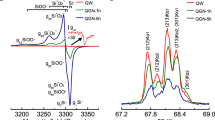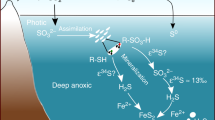Abstract
The earliest reductant for photosynthesis may have been H2. The carbon isotope composition measured in graphite from the 3.8-Ga Isua Supercrustal Belt in Greenland is attributed to H2-driven photosynthesis, rather than to oxygenic photosynthesis as there would have been no evolutionary pressure for oxygenic photosynthesis in the presence of H2. Anoxygenic photosynthesis may also be responsible for the filamentous mats found in the 3.4-Ga Buck Reef Chert in South Africa. Another early reductant was probably H2S. Eventually the supply of H2 in the atmosphere was likely to have been attenuated by the production of CH4 by methanogens, and the supply of H2S was likely to have been restricted to special environments near volcanos. Evaporites, possible stromatolites, and possible microfossils found in the 3.5-Ga Warrawoona Megasequence in Australia are attributed to sulfur-driven photosynthesis. Proteobacteria and protocyanobacteria are assumed to have evolved to use ferrous iron as reductant sometime around 3.0 Ga or earlier. This type of photosynthesis could have produced banded iron formations similar to those produced by oxygenic photosynthesis. Microfossils, stromatolites, and chemical biomarkers in Australia and South Africa show that cyanobacteria containing chlorophyll a and carrying out oxygenic photosynthesis appeared by 2.8 Ga, but the oxygen level in the atmosphere did not begin to increase until about 2.3 Ga.
Similar content being viewed by others
Abbreviations
- Bchl:
-
bacteriochlorophyll
- BIF:
-
banded iron formation
- Chl:
-
chlorophyll
- Ga:
-
billion years
- PDB:
-
Peedee belemnite standard
- RC:
-
reaction center
- Rubisco:
-
ribulose bisphosphate carboxylase
- WM:
-
Warrawoona Megasequence
References
Altermann W, Kazmierczak J, (2003) Archean microfossils: a reappraisal of early life on Earth Res Microbiol 154: 611–617
Altermann W (2005) The 3.5 Ga Apex fossil assemblage? Consequences of an enduring discussion, pp 136–137. 14th International Conference on the Origin of Life, 19–24 June, Bei**g, China
Awramik SM, Schopf JW, Walter MR, (1983) Filamentous fossil bacteria 3.5×109 years old from the Archean of Western Australia Precambrian Res 20: 357
Barley ME, (1993) Vulcanic, sedimentary and tectonostratigraphic environments of the approx. 3.46 Ga Warrawoona megasequence: a review Precambrian Res 60: 47–67
Bekker A, Holland HD, Wang P-L, Rumble D III, Stein HJ, Hannah JL, Coetzee LL, Beukes NJ, (2004) Dating the rise of atmospheric oxygen Nature 427:117–120
Blankenship RE, (2002) Molecular Mechanisms of Photosynthesis Blackwell Science, Oxford
Blankenship RE, Hartman H, (1998) The origin and evolution of oxygenic photosynthesis TIBS 23: 94–97
Borda MJ, Elsetinow AR, Schoonen MA, Strongin DR, (2001) Pyrite-induced hydrogen peroxide formation as a driving force in the evolution of photosynthetic organisms on an early Earth Astrobiology 1: 283–288
Brasier MD, Green OR, Jephcoat AP, Kleppe AK, Van Kranendonk MJ, Lindsay JF, Steel A, Grassineau NV, (2002) Questioning the evidence for Earth’s oldest fossils Nature 416: 76–81
Brasier M, Green O, Lindsay S, Steele J, (2004a) Earth’s oldest (∼ ∼3.5 Ga) fossils and the ‘Early Eden hypothesis’: questioning the evidence Origins Life Evol Biosphere 34: 257–269
Brasier MD, Green OR, McLoughlin N, (2004b) Characterization and critical testing of potential microfossils from the early Earth: the Apex ‘microfossil debate’ and its lessons for the Mars sample return Internat J Astrobiol 3: 139–150
Braterman PS, Cairns-Smith A, Sloper RW, (1983) Photo-oxidation of hydrated Fe2+ – significance for banded iron formation Nature 303: 163–164
Braterman PS, Cairns-Smith AG, Sloper RW, Truscott TG and Craw M (1984) Photo-oxidation of iron (II) in water between pH 7.5 and 4.0. J Chem Soc Dalton Trans 1441–1445
Brocks JJ, Logan GA, Buick R, Summons RE, (1999) Archean molecular fossils and the early rise of eukaryotes Science 285: 1033–1036
Buick R, (1992) The antiquity of oxygenic photosynthesis: evidence from stromatolites in sulfate-deficient Archean lakes Science 255: 74–77
Buick R, (2001) Life in the Archean. In: Briggs DEG, Crowther PR, (eds) Paleobiology II. Blackwell Science, Oxford, pp. 13–21
Buick R, Dunlop JRS, (1990) Evaporitic sediments of early Archean age from the Warrawoona Group, North Pole, Western Australia Sedimentology 37: 247–277
Buick R, Groves DI, (1995) Comment on abiological origin of described stromatolites older than 3.2 Ga Geology 23: 191
Canfield DE, Raiswell (1999) The evolution of the sulfur cycle Am J Sci 299: 687–723
Canfield DE, Kristensen E, Thamdrup B, (2005) Aquatic Geomicrobiology. Elsevier/Academic Press, Amsterdam
Catling DC, Zahnte KJ, McKay CP, (2001) Biogenic methane, hydrogen escape, and the irreversible oxidation of early Earth Science 293: 839–843
Cohen Y, (1989) Photosynthesis in cyanobacterial mats and its relation to the sulfur cycle: a model for microbial sulfur interactions. In: Cohen Y, Rosenberg E, (eds) Microbial Mats, Physiological Ecology of Benthic Communities. American Society of Microbiology, Washington, DC, pp 22–36
Colbeau A, Vignais PM, (1981) The membrane-bound hydrogenase of Rhodospeudomonas capsulata Biochim Biophys Acta 662: 271–284
Ehrenreich A, Widdel F, (1994) Anaerobic oxidation of ferrous iron by purple bacteria, a new type of phototrophic metabolism Appl Environ Microbiol 4: 4517–4526
Gogotov IN, (1987) Hydrogenases of green bacteria. In Olson JM, Ormerod JG, Amesz J, Stackebrandt E, Trüper HG, (eds) Green Photosynthetic Bacteria, Plenum Press, New York, pp 165–172
Hattori K, Cameron EM, (1986) Archean magmatic sulphate Nature 319: 45–47
Heising S, Schink B, (1998) Phototrophic oxidation of ferrous iron by a Rhodomicrobium vannieli strain Microbiology 144: 2263–2269
Heising S, Richter L, Ludwig W, Schink B, (1999) Chlorobium ferrooxidans sp. nov., a phototrophic green sulfur bacterium that oxidizes ferrous iron in coculture with a “Geospirillum” sp. strain Arch Microbiol 172: 116–124
House CH, Schopf JW, Stetter KO, (2003) Carbon isotope fractionation by Archeans and other thermophilic prokaryotes Organic Geochem 34: 345–356
Kasting J, (2001) The rise of atmospheric oxygen Science 293: 819–820
Kazmierczak J, Altermann W, (2002) Neoarchean biomineralization by benthic cyanobacteria Science 298: 2351
Konhauser KO, Hamade T, Raiswell R, Morris RC, Ferris FG, Southam G, Canfield DE, (2002) Could bacteria have formed the Precambrian banded iron formations? Geology 30: 1079–1082
Kump L, (2005) Ironing out biosphere oxidation Science 307: 1058–1059
Lowe DR, (1994) Abiological origin of described stromatolites older than 3.2 Ga Geology 22: 387–390
Mathez EA, Webster JD, (2004) The Earth Machine. Columbia University Press, New York
Mojzsis SJ, Arrhenius G, McKeegan KD, Harrison TM, Nutman AP, Friend CRL, (1996) Evidence for life on Earth before 3800 million years ago Nature 384: 55–59
Moorbath S, (2005) Palaeobiology: dating earliest life Nature 435: 155
Olson JM, (2001) ‘Evolution of Photosynthesis’ (1970), re-examined thirty years later Photosynth Res 68: 95–112
Olson JM, Blankenship RE, (2004) Thinking about the evolution of photosynthesis Photosynth Res 80: 373–386
Olson JM, Pierson BK, (1986) Photosynthesis 3.5 thousand million years ago Photosynth Res 9: 251–259
Padan E (1979) Annu Rev Plant Physiol 30: 27–40
Perry Jr EC, Monster J, Reimer T, (1971) Sulfur isotopes in Swaziland system barites and the evolution of the Earth’s atmosphere Science 171: 1015–1016
Rosing MT, (1999) 13C-depleted carbon microparticles in >3700-Ma sea-floor sedimentary rocks from West Greenland Science 283: 674–676
Rosing MT, Frei R, (2004) U-rich Archean sea-floor sediments from Greenland – indications of >3700 Ma oxygenic photosynthesis EPSL 217: 237–244
Schidlowsky M, (1988) A 3800-million-year isotopic record of life from carbon in sedimentary rocks Nature 333: 313–318
Schidlowsky M, Hayes JM, Kaplan IR, (1983) Isotopic inferences of ancient biochemistries: carbon, sulfur, hydrogen and nitrogen. In Schopf JW, (ed) Earth’s Earliest Biosphere, Princeton University Press, Princeton, New Jersey, pp 149–185
Schopf JW, (1993) Microfossils of the early Archean Apex chert: new evidence of the antiquity of life Science 260: 640–646
Schopf JW, Packer BM, (1987) Early Archean (3.3-billion to 3.5 billion-year-old) microfossils from the Warrawoona Group, Australia Science 237: 70–73
Schopf JW, Walter MR, (1983) Archean microfossils: new evidence of ancient microbes In Schopf JW, (ed) Earth’s Earliest Biosphere, Princeton University Press, Princeton, New Jersey, pp 214–239
Schopf JW, Kudryavtsev AB, Agresi DG, Wdowiak J, Czaja AD, (2002) Laser-Raman imagery of Earth’s earliest fossils Nature 416: 73–76
Shen Y, Buick R, Canfield DE, (2001) Isotopic evidence for microbial sulphate reduction in the early Archaean era Nature 410: 77–81
Summons RE, Janke LL, Hope JM, Logan GA, (1999) 2-Methylhopanoids as biomarkers for cyanobacterial oxygenic photosynthesis Nature 400: 554–557
Tian F, Toon OB, Pavlov AA, De Sterck H, (2005) A hydrogen-rich early Earth atmosphere Science 308: 1014–1017
Tice MM, Lowe DR, (2004) Photosynthetic microbial mats in the 3,416-Myr-old ocean Nature 431: 549–552
Turcotte DL, (1980) On the thermal evolution of the Earth Earth Planet Sci Lett 48: 53–58
Walker JCG, (1983) Possible limits on the composition of the Archean ocean Nature 302: 518–520
Walter MR, (1983) Archean stromatolites: evidence of the Earth’s earliest benthos. In: Schopf JW, (ed) Earth’s Earliest Biosphere, Princeton University Press, Princeton, New Jersey, pp 187–213
Acknowledgements
I thank Minik Rosing (Geology Museum, Copenhagen) for showing me his rock samples and for teaching me some basic geology. I also thank Mette Miller (University of Southern Denmark) and Don Bryant (Pennsylvania State University) for critical comments on earlier versions of this article. Thanks are also due to two anonymous reviewers for additional valuable comments.
Author information
Authors and Affiliations
Corresponding author
Appendix
Appendix
Amount of graphite formed by H2-driven photosynthesis
On the basis of Tian et al. (2005), I assume a volcanic outgassing rate of ca. 9×1010 H2 molecules cm−2 s−1, which is 5 times that of today due to higher heat flow in the past (Turcotte 1980). This is equivalent to ca. 3×1018 H2 cm−2 year−1. From Rosing and Frei (2004), the accumulated stratigraphic thickness of pelagic shale in the exposed section is ca. 20 m, suggesting that a steady sedimentation of pelagic organic matter took place during hundred thousands to millions of years. I assume that the sedimentary rock took ∼ ∼106 years to form, and that ∼ ∼3×1024 H2 molecules cm−2 were outgassed during this period. I assume that essentially all the H2 was used for CO2 fixation according to the equation, CO2 + 2H2 → CH2O + H2O. The amount of carbon fixed would have been ∼ ∼1.5×1024 C atoms cm−2 or 2.4 g atom C cm−2 or 28 g C cm−2. For a rock thickness of 20 m, the concentration of C (as graphite) would be 0.014 g cm−3, and assuming a rock density of 2–3 g cm−3, the C content would be 0.5–0.7%.
Rights and permissions
About this article
Cite this article
Olson, J.M. Photosynthesis in the Archean Era. Photosynth Res 88, 109–117 (2006). https://doi.org/10.1007/s11120-006-9040-5
Received:
Accepted:
Published:
Issue Date:
DOI: https://doi.org/10.1007/s11120-006-9040-5
Keywords
- anoxygenic photosynthesis
- bacteriochlorophyll
- banded iron formation
- Buck Reef Chert
- chemical biomarkers
- chlorophyll
- cyanobacteria
- Fortesque Group
- evaporites
- ferrous iron
- hydrogen
- isotope fractionation
- Isua Supercrustal Belt
- microfossils
- oxygenic photosynthesis
- proteobacteria
- reaction center
- reductants for CO2 fixation
- stromatolites
- Swaziland Sequence
- Warrawoona Megasequence




